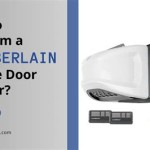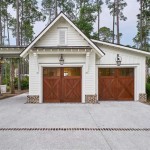Craftsman Garage Door Opener Troubleshooting
Craftsman garage door openers are a popular choice for homeowners, known for their reliability and affordability. However, like any mechanical device, they can experience problems over time. Understanding common issues and troubleshooting techniques is essential for maintaining the functionality and security of the garage door system. This article provides a comprehensive guide to troubleshooting common Craftsman garage door opener problems.
Safety Precautions Before Troubleshooting
Prior to performing any troubleshooting steps, it is crucial to prioritize safety. Disconnect the garage door opener from the power outlet to prevent accidental operation during the diagnostic process. This simple step can prevent injury or further damage to the equipment. Additionally, ensure that the garage door is fully closed and supported by its springs. A malfunctioning opener could cause the door to come crashing down if not properly secured. If the door is in a partially open position, use clamps or other appropriate supports to prevent unexpected movement. Wear safety glasses to protect the eyes from debris that may dislodge during inspection and repair. Finally, never attempt repairs beyond one's skill level. If unsure about a procedure, it is always best to consult a qualified garage door technician.
Diagnosing Common Problems
Effective troubleshooting begins with a systematic approach to identify the source of the problem. Start by observing the behavior of the garage door opener and noting any unusual sounds, movements, or error codes. Common symptoms include the door not opening or closing, operating intermittently, making excessive noise, or reversing direction unexpectedly. Once the symptoms are clearly defined, the next step is to examine the various components of the system, including the remote controls, wall button, sensors, motor, and wiring. Visual inspection can reveal obvious issues such as broken wires, loose connections, or damaged parts. Consult the Craftsman garage door opener owner's manual for specific troubleshooting instructions and diagrams relevant to the model.
The following sections elaborate on the common problems encountered with Craftsman garage door openers, along with troubleshooting steps to resolve the issues.
Garage Door Opener Not Responding
A common problem is the garage door opener failing to respond to remote or wall button activation. The first step is to check the power supply. Verify that the opener is plugged into a functioning electrical outlet and that the circuit breaker has not tripped. If the outlet is working, test the wall button by pressing it firmly. If the door still does not respond, the issue may lie with the remote controls or the opener's receiver.
Remote controls often require fresh batteries. Replace the batteries in all remote controls and attempt to operate the door again. If new batteries do not resolve the problem, try reprogramming the remotes to the opener. Refer to the owner's manual for specific programming instructions. Typically, this involves pressing a "Learn" button on the opener motor unit and then pressing a button on the remote control until the opener lights flash or clicks. If the remote controls still do not work after reprogramming, the receiver in the opener may be faulty and require replacement.
Another possible cause is interference from other electronic devices. Cordless phones, wireless routers, and other electronic equipment can sometimes interfere with the garage door opener's signal. Try temporarily disabling or moving these devices to see if the interference is eliminated. In some cases, installing a surge protector may help to filter out electrical noise and prevent interference.
Garage Door Opens or Closes Partially
If the garage door opens or closes only partially, the problem may be related to the travel limits or the force settings. Travel limits determine how far the door opens and closes, while the force settings control the amount of force the opener applies to move the door. If these settings are not properly adjusted, the door may stop prematurely or reverse direction unexpectedly.
To adjust the travel limits, locate the adjustment screws or buttons on the opener motor unit. These are typically labeled "Up" and "Down" or with arrows indicating the direction of travel. Use a screwdriver or follow the instructions in the owner's manual to fine-tune the limits. Open the door fully and observe its position. If it does not open completely, increase the "Up" travel limit slightly. Similarly, close the door fully and adjust the "Down" travel limit until the door seals properly against the floor. Ensure that the door does not bind or struggle to close. If it does, reduce the "Down" travel limit. After adjusting the travel limits, test the door several times to ensure it operates smoothly and reliably.
The force settings should also be checked. These settings determine the sensitivity of the opener to obstructions. If the force is set too low, the door may reverse direction unnecessarily. If the force is set too high, the door could potentially damage objects or injure people. Adjust the force settings according to the instructions in the owner's manual. Typically, this involves turning adjustment knobs or pressing buttons to increase or decrease the force. After adjusting the force settings, test the door by placing a 2x4 board on the floor in the path of the closing door. The door should stop and reverse direction when it contacts the board. If it does not, decrease the "Down" force setting until it does. Repeat this test several times to ensure consistent performance.
Garage Door Reverses Immediately After Closing
When a garage door reverses immediately after closing, it suggests an issue with the safety sensors or an obstruction in the door's path. The safety sensors are located near the bottom of the door tracks and are designed to prevent the door from closing if an object or person is in the way. These sensors emit an invisible beam of light that, when interrupted, triggers the opener to reverse direction.
First, inspect the safety sensors for any obstructions, such as dirt, debris, or cobwebs. Clean the lenses of the sensors with a soft cloth to ensure they are clear. Also, verify that the sensors are properly aligned. Most sensors have an indicator light that illuminates when they are aligned correctly. If the light is not on, adjust the position of the sensors until the light turns on. The sensors may need to be repositioned if they have been bumped or knocked out of alignment. Tightening the mounting screws can help secure the sensors in place.
If the sensors are clean and aligned, check the wiring connections. Look for loose wires, broken connections, or damaged insulation. Repair or replace any damaged wires. Ensure that the wires are securely connected to the sensors and the opener motor unit. If the wiring appears to be intact, the sensors themselves may be faulty and require replacement. Before replacing the sensors, use a multimeter to test the voltage at the sensor terminals. If the voltage is not within the specified range, the problem may lie with the opener's control board.
Garage Door Makes Excessive Noise
Excessive noise from a garage door opener can be indicative of several underlying problems. Common sources of noise include worn-out rollers, a loose chain or belt, or a faulty motor. Identifying the source of the noise is crucial for effective troubleshooting.
Start by inspecting the rollers. Over time, the rollers can become worn, cracked, or flattened, causing them to bind and squeal as they move along the tracks. Replace any damaged rollers with new ones. Use nylon rollers instead of steel rollers, as nylon rollers are quieter and more durable. Lubricate the rollers and tracks with a silicone-based lubricant. Avoid using oil-based lubricants, as they can attract dirt and debris.
If the opener uses a chain or belt drive system, check the tension. A loose chain or belt can cause the opener to make rattling or grinding noises. Adjust the tension according to the instructions in the owner's manual. Typically, this involves tightening or loosening adjustment bolts on the trolley or rail. Ensure that the chain or belt is not too tight, as this can put excessive strain on the motor. After adjusting the tension, lubricate the chain or belt with a garage door lubricant.
A noisy motor may indicate worn-out bearings or gears. If the motor is making a loud humming or grinding noise, it may be necessary to replace the motor. Before replacing the motor, check the motor mounting bolts to ensure they are tight. Loose mounting bolts can cause the motor to vibrate excessively. Additionally, inspect the capacitors in the motor. A faulty capacitor can cause the motor to run erratically or make unusual noises. If the capacitors are bulging or leaking, they should be replaced. Consult a qualified electrician for assistance with electrical repairs.
Garage Door Opener Remote Not Working
When the garage door opener remote stops functioning, the initial step involves verifying the battery status. Replacing the batteries with new ones can resolve the issue if the old batteries were depleted. If the problem persists, it might be necessary to reprogram the remote to the garage door opener. This typically involves pressing a "Learn" button on the opener motor unit, followed by pressing a button on the remote control until the opener lights flash or click, indicating successful synchronization. In cases where multiple remotes are used, ensure that each remote undergoes the reprogramming process individually.
Sometimes, the issue may not be with the remote itself but with the opener's receiver. Interference from other electronic devices can disrupt the signal between the remote and the receiver. Try moving or temporarily disabling nearby electronic devices like cordless phones or wireless routers to see if this resolves the problem. If the receiver is the issue, it may require replacement. This usually involves disconnecting the old receiver from the motor unit and installing the new one, following the manufacturer's instructions carefully.
Another potential cause could be damage to the remote control. Inspect the remote for any signs of physical damage, such as cracks or broken buttons. If the remote is damaged, it may need to be replaced. It is also possible that the remote has simply malfunctioned. In this case, purchasing a new remote and programming it to the opener should resolve the issue.
Garage Door Opener Wall Button Not Working
When the wall button fails to activate the garage door opener, the initial check should focus on the wiring connecting the button to the opener motor unit. Examine the wires for any signs of damage, such as cuts, breaks, or loose connections. Ensure that the wires are securely connected to both the wall button and the motor unit. If any damaged wires are found, they should be repaired or replaced immediately.
If the wiring appears to be in good condition, the next step is to test the wall button itself. Use a multimeter to check for continuity across the button terminals when the button is pressed. If there is no continuity, the wall button is likely faulty and needs to be replaced. Replacement involves disconnecting the old button from the wiring and connecting the new button in its place, ensuring all connections are secure.
In some cases, the problem may not be with the wall button or wiring, but with the opener's control board. A faulty control board may not send the necessary signals to activate the opener when the wall button is pressed. Testing the control board requires specialized knowledge and equipment. If you suspect a faulty control board, it is best to consult a qualified garage door technician for diagnosis and repair.

Craftsman Garage Door Opener Repair

How To Fix A Garage Door Opener That Won T Close The Lights Blink 10 Times

Garage Door Won T Open Or Close Force Adjustments

Garage Door Opener Doesn T Work Wall Control Troubleshooting

How To Fix A Garage Door Opener That Won T Open The Remotes Don Work

The Most Common Garage Door Opener Problems And Their Troubleshooting Phoenician Doors Inc
Craftsman Garage Door Opener Troubleshooting 2024 Guide
Craftsman Garage Door Opener Troubleshooting 2024 Guide

Garage Door Opener Repair And Troubleshoting

Craftsman Garage Door Opener Troubleshooting 2024 Guide
Related Posts








